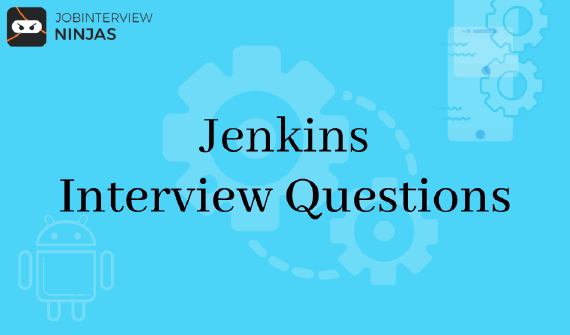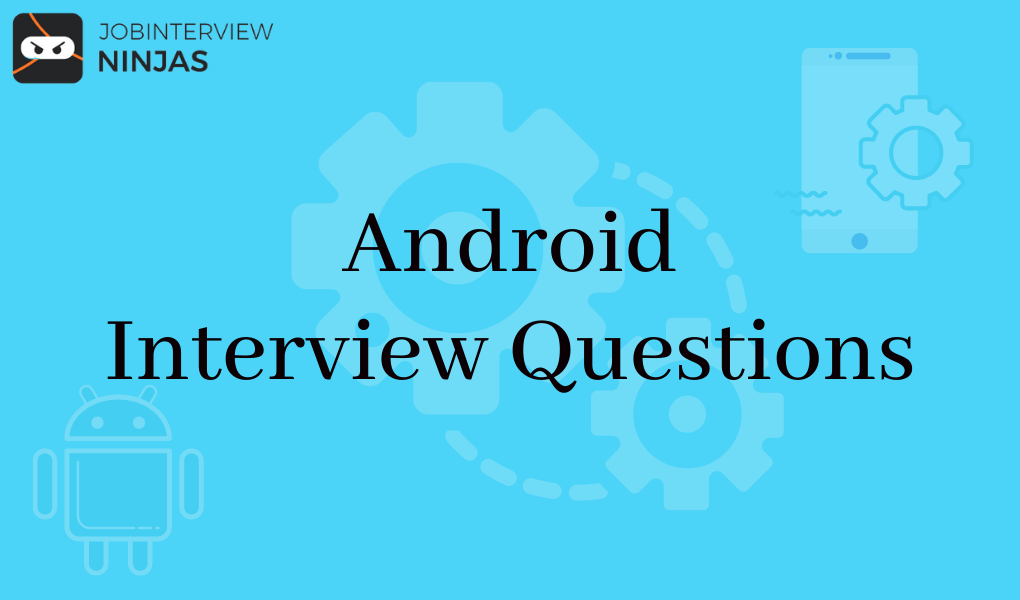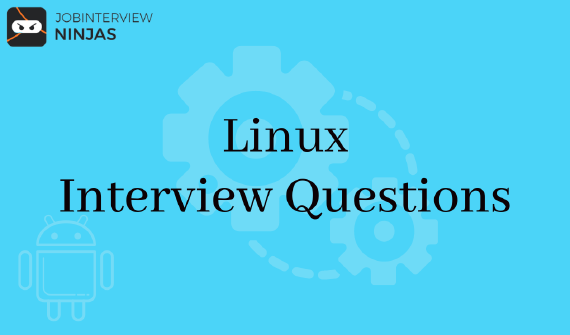
Top 40 Jenkins Interview Questions And Answers For Freshers/Experienced
If you are looking for a career in software development, then Jenkins is definitely worth exploring. This widely used …

Android is a very popular and wide part of an operating system and if you are appearing for a company interview then you need to prepare well to crack the Interview on Android. So here we present you Android Interview Questions and Answers to cope up with your upcoming interviews. These questions will help the professionals and beginners to prepare for the Interviews.
About Android: It is an operating system founded by Andy Rubin which is available in open-source is lightweight and is used in functioning smartphones etc. It is an operating system based on Linux which permits developers to run apps that can perform basic and advanced functionalities.
3. Explain service in Android?
4. What is the difference between Activities from Services?
5. Explain Google Android SDK?
6. Tell the use of Bundle in Android?
7. What is an Adapter in Android?
9. Explain portable Wi-Fi hotspots?
10. Explain Android Debug Bridge (ADB)?
12. Explain AIDL and the data types supported by it?
13. Explain the complete life cycle of Android activity?
14. What do you understand by Sensors in Android?
15. Explain the AndroidManifest.xml file and its need?
17. Differentiate class, file, and activity in Android?
18. Explain Toast with syntax.
20. Differentiate Implicit and Explicit Intent.
22. Tell the troubleshooting techniques you use if the application is crashing frequently?
23. What do you understand by broadcast receivers and how is it implemented?
24. Name the founder of the Android operating system?
25. Describe Android Application Architecture?
26. Tell some advantages of Android?
27. Does android support programming languages other than java?
28. Name the core building blocks of android?
29. How to identify view elements in the android program?
30. Name some impotent folders in android
31. Tell us the use of LINUX ID in android?
32. Name the different storage provided by Android.
33. What is the command to call another activity in android?
34. Which database is used in android?
37. What is the nine-patch images tool in Android?
38. Which kernel is used in Android?
39. What flags are used to run an application on Android?
40. Name any 4 dialogs boxesan a run the arethe supported by Android?
41. What are some exceptions in Android?
42. Name the basic tools used to develop an Android app?
43. Name all versions of Android.
44. What are the disadvantages of Android?
45. What are Google Android SDK tools used in it.
46. What is the role of Dalvik in Android development?
48. Explain content provider? How it is implemented?
49. What is the role of the .dex file?
3. Explain service in Android?
4. What is the difference between Activities from Services?
5. Explain Google Android SDK?
6. Tell the use of Bundle in Android?
Bundles are required to transmit the data between different Android activities. These work as a HashMap that takes trivial data. The below-given code tells you how to transfer the data by using bundle:
Bundle b=new Bundle();
b.putString(“Email”,“abc@xyz.com”);
i.putExtras(b); // where i is intent
7. What is an Adapter in Android?
9. Explain portable Wi-Fi hotspots?
10. Explain Android Debug Bridge (ADB)?
12. Explain AIDL and the data types supported by it?
13. Explain the complete life cycle of Android activity?
14. What do you understand by Sensors in Android?
15. Explain the AndroidManifest.xml file and its need?
It is a messaging object that requests an action to be done from other components of an application. It is used to begin an activity, send SMS, email, show a web page, etc. It displays messages notification to the user on an Android-enabled device. It also shows the alerts to users of a particular state.
Two types of Intents are:
17. Differentiate class, file, and activity in Android?
Class is a collected form of a .java file that is used to create an executable .apk file for Android.
A file is a bundle of information, resources which store information. It can be of any file type.
Activity is a single screen that shows GUI (Graphical User Interface) which allows users to do something like dial the phone, view email, etc.
18. Explain Toast with syntax.
It is a popup message that displays on the screen. It shows the status of the operation started by the user and only covers the space required for the message while the user activity remains active. The Toast notification fades in and out if it does not interact.
Syntax:
Toast.makeText(ProjectActivity.this, “Your message here”, Toast.LENGTH_LONG).show();
The context of the present state of the application or object in Android. It comes with services like providing access to databases, resolving resources, etc.
Two types of context are:
Activity context: It is involved in the lifecycle of an activity. It can be used when you are allowing the context in the possibility of an activity or the context whose lifecycle is attached to the activity.
Application context: It is involved in the lifecycle of an application. It is used when you need a context where the lifecycle is separated from the present context or when you are allowing a context further than the scope of activity.
20. Differentiate Implicit and Explicit Intent.
Explicit Intent: It is where you notify the system that which activity needs to handle this intent. In this, the targeted component is mentioned directly in the intent.
For example,
Intent i = new Intent(this, Activitytwo.class); #ActivityTwo is the target component
i.putExtra(“Value1”,“This is ActivityTwo”);
i.putExtra(“Value2”,“This Value two for ActivityTwo”);
startactivity(i);
Implicit Intent: It allows you to announce the action you want to run. The Android system checks the components which are going to handle that particular action based on intent data. Here target component is not mentioned in the intent.
For example,
Intent i = new Intent(ACTION_VIEW,Uri.parse(“http://www.interview bit.com”));
startActivity(i);
Follow Simple Steps to apply in these MNC’s:
22. Tell the troubleshooting techniques you use if the application is crashing frequently?
Compatibility Check: There might be chances that an application is not compatible with the Android operating system.
Memory Management:
23. What do you understand by broadcast receivers and how is it implemented?
It is a mechanism that listens to system-level events like incoming calls, SMS, etc. by the host application. It is implemented as a subclass of BroadcastReceiver class and each message is broadcasted as an intent object.
public class MyReceiver extends BroadcastReceiver
{
public void onReceive(context,intent){}
}
24. Name the founder of the Android operating system?
25. Describe Android Application Architecture?
26. Tell some advantages of Android?
27. Does android support programming languages other than java?
28. Name the core building blocks of android?
29. How to identify view elements in the android program?
30. Name some impotent folders in android
31. Tell us the use of LINUX ID in android?
32. Name the different storage provided by Android.
33. What is the command to call another activity in android?
Intent i = new Intent(getApplicationContext(), ActivityTwo.class);
startActivity(i);
34. Which database is used in android?
37. What is the nine-patch images tool in Android?
38. Which kernel is used in Android?
39. What flags are used to run an application on Android?
You may also prepare:
40. Name any 4 dialogs boxesan a run the arethe supported by Android?
41. What are some exceptions in Android?
42. Name the basic tools used to develop an Android app?
43. Name all versions of Android.
Android 11.0 is the latest version released in September 2020. Most of the Android version has been named after either sweet or desserts.
| — | — | — | — | | Version | Android Name | API Level | Year of Release | | Android 1.0 | No Codename | 1 | 2008 | | 1.1 | No Codename | 2 | 2009 | | 1.5 | Cupcake | 3 | 2009 | | 1.6 | Donut | 4 | 2009 | | 2.0 - 2.1 | Éclair | 5 - 7 | 2009 | | 2.2 – 2.2.3 | Froyo | 8 | 2010 | | 2.3 – 2.3.7 | Gingerbread | 9 - 10 | 2010 | | 3.0 – 3.2.6 | Honeycomb | 11 - 13 | 2011 | | 4.0 – 4.0.4 | Ice Cream Sandwich | 14 - 15 | 2011 | | 4.1 – 4.3.1 | Jelly Bean | 16 – 18 | 2012 | | 4.4 – 4.4.4 | Kitkat | 19 – 20 | 2013 | | 5.0 – 5.1.1 | Lollipop | 21 – 22 | 2014 | | 6.0 – 6.0.1 | Marshmallow | 23 | 2015 | | 7.0 – 7.1.2 | Nougat | 24 – 25 | 2016 | | 8.0 – 8.1 | Oreo | 26 – 27 | 2017 | | 9.0 | Pie | 28 | 2018 | | 10.0 | Android 10 | 29 | 2019 | | 11.0 | Android 11 | 30 | 2020 |
44. What are the disadvantages of Android?
45. What are Google Android SDK tools used in it.
46. What is the role of Dalvik in Android development?
47. Explain a database in Android? How it is different from client-server database management systems?
48. Explain content provider? How it is implemented?
It is one of the main building blocks of Android applications, which copes access to a central repository. It works as an interface that connects data and code from one process to another process.
They are responsible for encapsulating the data and providing mechanisms for defining data security. It is implemented as a subclass of ContentProviderclass and must implement a set of APIs that will enable other applications to perform transactions.
public class MyContentprovider extends ContentProvider
{
public void onCreate(){}
}
49. What is the role of the .dex file?

If you are looking for a career in software development, then Jenkins is definitely worth exploring. This widely used …

In this post, we will cover a few Linux interview questions and their answers. So, let’s get started. In this …